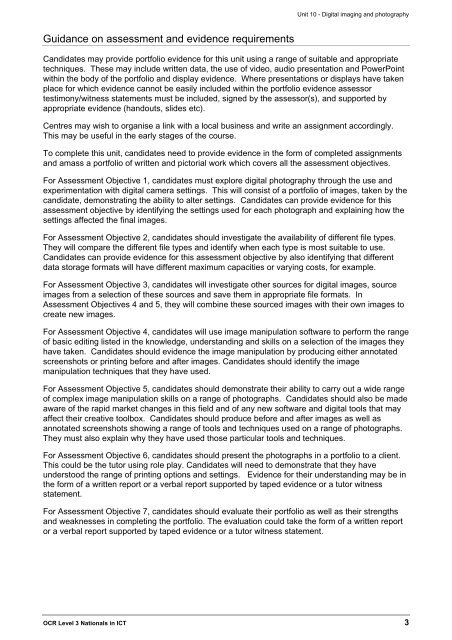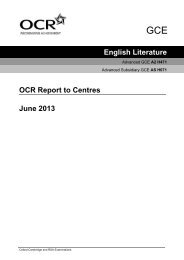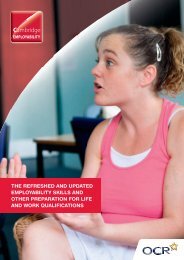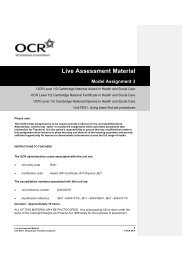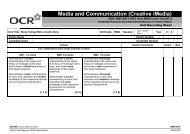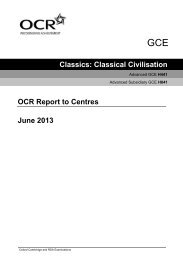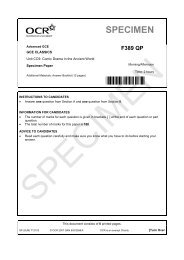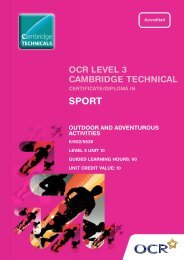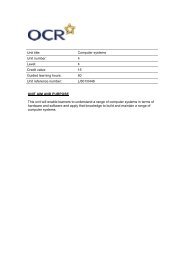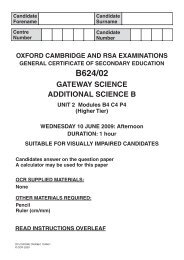Unit 10: Digital imaging and photography (LEVEL 3) - OCR
Unit 10: Digital imaging and photography (LEVEL 3) - OCR
Unit 10: Digital imaging and photography (LEVEL 3) - OCR
Create successful ePaper yourself
Turn your PDF publications into a flip-book with our unique Google optimized e-Paper software.
Guidance on assessment <strong>and</strong> evidence requirements<br />
<strong>Unit</strong> <strong>10</strong> - <strong>Digital</strong> <strong>imaging</strong> <strong>and</strong> <strong>photography</strong><br />
C<strong>and</strong>idates may provide portfolio evidence for this unit using a range of suitable <strong>and</strong> appropriate<br />
techniques. These may include written data, the use of video, audio presentation <strong>and</strong> PowerPoint<br />
within the body of the portfolio <strong>and</strong> display evidence. Where presentations or displays have taken<br />
place for which evidence cannot be easily included within the portfolio evidence assessor<br />
testimony/witness statements must be included, signed by the assessor(s), <strong>and</strong> supported by<br />
appropriate evidence (h<strong>and</strong>outs, slides etc).<br />
Centres may wish to organise a link with a local business <strong>and</strong> write an assignment accordingly.<br />
This may be useful in the early stages of the course.<br />
To complete this unit, c<strong>and</strong>idates need to provide evidence in the form of completed assignments<br />
<strong>and</strong> amass a portfolio of written <strong>and</strong> pictorial work which covers all the assessment objectives.<br />
For Assessment Objective 1, c<strong>and</strong>idates must explore digital <strong>photography</strong> through the use <strong>and</strong><br />
experimentation with digital camera settings. This will consist of a portfolio of images, taken by the<br />
c<strong>and</strong>idate, demonstrating the ability to alter settings. C<strong>and</strong>idates can provide evidence for this<br />
assessment objective by identifying the settings used for each photograph <strong>and</strong> explaining how the<br />
settings affected the final images.<br />
For Assessment Objective 2, c<strong>and</strong>idates should investigate the availability of different file types.<br />
They will compare the different file types <strong>and</strong> identify when each type is most suitable to use.<br />
C<strong>and</strong>idates can provide evidence for this assessment objective by also identifying that different<br />
data storage formats will have different maximum capacities or varying costs, for example.<br />
For Assessment Objective 3, c<strong>and</strong>idates will investigate other sources for digital images, source<br />
images from a selection of these sources <strong>and</strong> save them in appropriate file formats. In<br />
Assessment Objectives 4 <strong>and</strong> 5, they will combine these sourced images with their own images to<br />
create new images.<br />
For Assessment Objective 4, c<strong>and</strong>idates will use image manipulation software to perform the range<br />
of basic editing listed in the knowledge, underst<strong>and</strong>ing <strong>and</strong> skills on a selection of the images they<br />
have taken. C<strong>and</strong>idates should evidence the image manipulation by producing either annotated<br />
screenshots or printing before <strong>and</strong> after images. C<strong>and</strong>idates should identify the image<br />
manipulation techniques that they have used.<br />
For Assessment Objective 5, c<strong>and</strong>idates should demonstrate their ability to carry out a wide range<br />
of complex image manipulation skills on a range of photographs. C<strong>and</strong>idates should also be made<br />
aware of the rapid market changes in this field <strong>and</strong> of any new software <strong>and</strong> digital tools that may<br />
affect their creative toolbox. C<strong>and</strong>idates should produce before <strong>and</strong> after images as well as<br />
annotated screenshots showing a range of tools <strong>and</strong> techniques used on a range of photographs.<br />
They must also explain why they have used those particular tools <strong>and</strong> techniques.<br />
For Assessment Objective 6, c<strong>and</strong>idates should present the photographs in a portfolio to a client.<br />
This could be the tutor using role play. C<strong>and</strong>idates will need to demonstrate that they have<br />
understood the range of printing options <strong>and</strong> settings. Evidence for their underst<strong>and</strong>ing may be in<br />
the form of a written report or a verbal report supported by taped evidence or a tutor witness<br />
statement.<br />
For Assessment Objective 7, c<strong>and</strong>idates should evaluate their portfolio as well as their strengths<br />
<strong>and</strong> weaknesses in completing the portfolio. The evaluation could take the form of a written report<br />
or a verbal report supported by taped evidence or a tutor witness statement.<br />
<strong>OCR</strong> Level 3 Nationals in ICT 3


